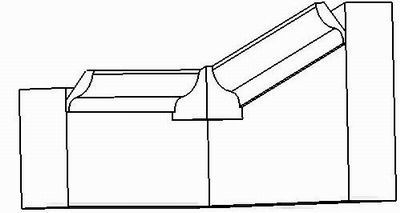Matching Stair Stringer Trim to Baseboard
Advice on making stair stringer trim match up nicely with baseboard on the floor or landing. October 23, 2007
Question
I have a question that may seem so simple that it is basically skipped over in any description of the installation of stair skirt boards. I am installing cherry veneered skirt board on two stairways. One is simply a straight run and the other has a landing and turns 90 degrees. My question is in cutting the ends of the boards. How tall should the 90 degree terminations be at each end of the run? I think that where they meet base moulding, they should be slightly taller than the base? On the landing, should I continue using the skirt board material, or should I use standard base moulding on the horizontal level? More importantly, how should I handle the transition from the skirt to the base? What is recommended for covering up the cut ends of the veneered skirting?
Forum Responses
(Architectural Woodworking Forum)
From contributor J:
I would use the skirt material as base on the landing. Mitering that transition looks better than squaring up the end of the skirt. Since you need to cover the top of the un-veneered skirt, I would use a rabbeted cap that came down a bit (1/4") on the face of the skirt. Or... use a cap that is just wide enough to cover the un-veneered skirt.
From contributor D:
I think you're referring to the finish stringer, where it meets the landing base. If so, what I usually do on a field install is lay out and snap lines around the entire staircase to get my exact meeting points where the finish stringer and landing base meet. Once all my lines are snapped, I can figure my tail cuts on both the top and bottom of the finish stringer where they meet the base, because I use a chalk line to layout. It's used only as a general starting point and you will have to fine tune your angles as you go. Use flat stock around the entire staircase and a rabbeted base cap to cover the veneer, as mentioned in the previous post.
From the original questioner:
The actual veneered skirt that I have looks like a very tall base board. The top is already moulded with a shape. The un-veneered edges will just be the cut ends. Would you recommend something like a plinth block at the transition to the base board, or mitering the ends like a return and then coping the baseboard over the skirt shape?
From contributor I:
I would do as contributor J said. If you can't get more skirt for some reason, I would rip off the top detail, buy or mill a separate cap to use on both the skirt and the base.
From contributor S:
This should be called out on the plans, but welcome to the real world. Pop your layout lines everywhere to make sure that you don't put yourself in a situation where your skirt is too short (no pun intended... okay, yes it was). The rise/run is going to determine the angles of the intersections at the landings. Keep in mind that you have to bisect these angles in order for the moulded profiles to mate. Provided that your skirt is taller than any base that will butt into it, level it out either at the point it hits the floor with a miter to the level run and a plumb return back to the wall, or keep running it to a more suitable point like an inside corner or door opening or a change in floor material, what have you. If you do have to meet base to your skirt, the skirt returned on itself will hopefully be taller than the base and allow the base just to butt up to it. Hopefully the base cap or top profile will not need to be coped into the top profile of the skirt. If your base is taller or close to the height of the skirt you may want to consider turning to level and returning back on itself a little further up the first riser so that it looks like the skirt was taller. I think that any vestibule or bottom landing area should be treated like it is part of the stairs to make the staircase look more impressive.
From the original questioner:
Thank you guys so much for your advice.
